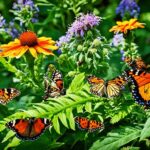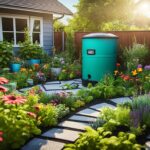“eco-friendly gardening practices”
How to Attract Beneficial Wildlife to Your Garden
Ever thought about making your garden a home for many creatures? It’s all about creating a space that meets the needs of local wildlife. With a few easy changes, your garden can become a safe spot for pollinators, birds, and small animals.
Key Takeaways
- Grow native plants to attract pollinators and provide food and shelter for wildlife
- Offer supplemental food and water sources to support a variety of species
- Create shelters and nesting spots to give wildlife a safe place to live and raise their young
- Maintain a compost pile to recycle organic matter and provide a nutrient-rich habitat
- Avoid pesticides and embrace natural, organic gardening practices
Imagine your garden as a lively oasis for many creatures. Learn how to make your outdoor area a welcoming place for pollinators, birds, and wildlife.
Grow Native Plants for Wildlife
Native plants are crucial for a wildlife-friendly garden. They’ve grown with local animals, offering them food, shelter, and resources. By using many native species, you’ll draw in different kinds of wildlife to your garden.
Native Wildflowers for Pollinators
Native wildflowers help pollinators like bees, butterflies, and hummingbirds. Great choices include forget-me-not, red campion, foxglove, and chamomile. These flowers make your garden look great and feed pollinators all season.
Trees and Shrubs that Provide Shelter and Food
Native trees and shrubs are key for wildlife. Think about adding silver birch, wild cherry, dogwood, and dog rose. They give shelter, nesting spots, and food like berries and seeds to birds, insects, and small mammals.
With a mix of native plants, your garden will become a lively place for wildlife. From pollinators to songbirds, it will be full of activity and life.
“Incorporating native plants is the single most effective thing a homeowner can do to support local wildlife.”
Provide Supplemental Food and Water Sources
Attracting wildlife to your garden isn’t just about native plants. Adding food and water can really help local animals. Whether you want to feed birds or help pollinators, the right additions can turn your garden into a wildlife paradise.
Feeding Birds and Butterflies
Setting up bird feeders with seeds, nuts, and suet can attract many birds. You’ll see everything from bright cardinals to busy woodpeckers. For butterflies and pollinators, plant nectar-rich flowers or leave out ripe fruit. They love it!
When you offer wildlife feeding, keep things balanced. Don’t let animals rely too much on your food. Clean your feeders often to keep them healthy. With care, you can create great bird feeders and butterfly nectar sources for your garden.
“Providing a diversity of food sources, both natural and supplemental, is key to supporting a wide range of wildlife in your backyard.”
| Supplemental Food Source | Wildlife Attracted |
|---|---|
| Bird Feeders (seeds, nuts, suet) | Songbirds, Woodpeckers, Chickadees, Nuthatches |
| Nectar-Rich Flowers | Butterflies, Hummingbirds, Bees, Moths |
| Rotting Fruit | Butterflies, Beetles, Flies |
Create Shelters and Nesting Spots
Turn your garden into a wildlife paradise by adding shelters and nesting spots. Use bird houses, bug hotels, frog pots, and hedgehog houses to draw in many creatures. These places offer protection from predators and harsh weather. They also provide breeding and shelter for various species.
When picking shelters, think about what the local wildlife needs. Make sure bird houses have the right size and entrance for the birds. Bug hotels should have different chambers and materials for various insects. Choose hedgehog houses with lots of space and soft bedding for these prickly visitors.
| Shelter Type | Suitable Wildlife | Key Features |
|---|---|---|
| Bird Houses | Songbirds, Woodpeckers | Varied entrance sizes, Proper ventilation, Durable materials |
| Bug Hotels | Bees, Ladybugs, Lacewings | Diverse chambers, Natural materials, Sheltered location |
| Hedgehog Houses | Hedgehogs | Ample space, Cozy bedding, Sheltered entrance |
| Frog Pots | Frogs, Toads | Partially buried, Moist substrate, Hiding spots |
Choosing and placing the right shelters can really boost the variety of species in your garden. These safe spots turn your garden into a sanctuary for many helpful creatures.
Add a Water Feature like a Pond
Having a reliable water source is key for drawing and keeping wildlife in your garden. Even a small garden pond or a shallow dish of water can be a big help. Ponds offer drinking water and a spot for amphibians to breed. They also attract insects that feed birds and bats.
Benefits of a Garden Pond
Adding a water source for wildlife to your garden has many perks. It draws in a wide variety of species and supports a healthy ecosystem. A well-thought-out garden pond becomes a lively spot. Here, dragonflies, frogs, and even birds and mammals find shelter and food.
Designing a Wildlife-Friendly Pond
When making a wildlife-friendly pond, think about sloping edges, aquatic plants, and different depths. This setup supports a variety of species. By adding these features, your garden turns into a haven for many beneficial creatures.
- Include sloping edges to allow easy access for drinking and bathing
- Incorporate aquatic plants to provide shelter and food for pond-dwelling creatures
- Vary the depth of the pond to accommodate different species
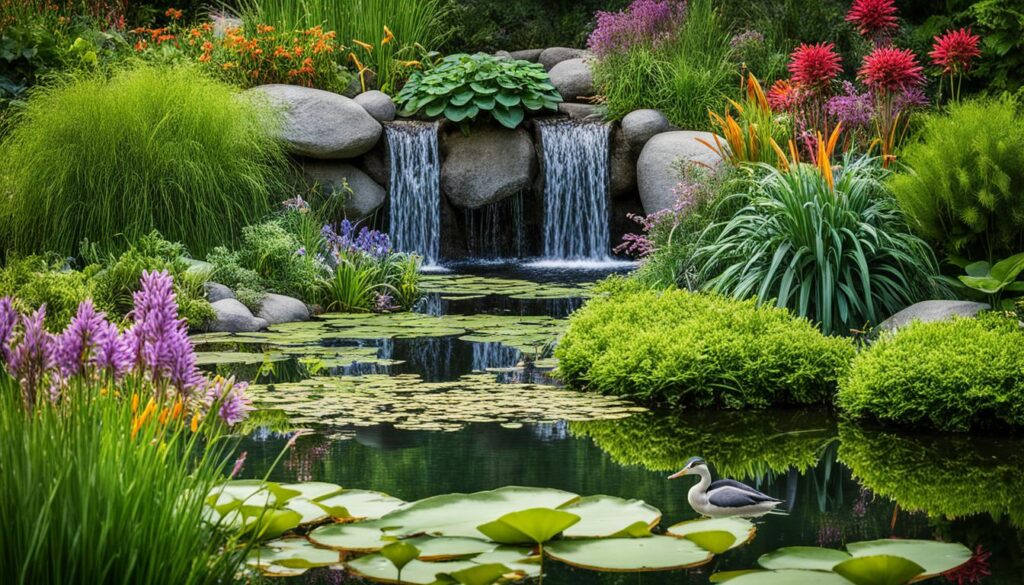
“A garden pond is a magical addition to any outdoor space, transforming it into a vibrant hub of life and activity.”
Maintain a Compost Pile
Creating a compost pile in your garden is great for many decomposer organisms like worms, slugs, and snails. These creatures are key in breaking down organic matter and giving nutrients back to the soil. Compost heaps also give shelter and places to survive the winter for small animals. Keeping a healthy compost pile boosts your garden’s biodiversity.
To start with composting for wildlife, just follow these easy steps:
- Pick a good spot for your garden compost pile, ideally in a shaded area to keep it moist.
- Gather different organic materials, like dead leaves, plant cuttings, and kitchen scraps (but not meat or dairy).
- Layer the materials in the pile, switching between “green” (high in nitrogen) and “brown” (high in carbon) stuff.
- Turn and aerate the compost often to help it break down evenly and stop bad smells.
- Check the compost’s moisture and add water if it’s too dry.
- Wait a few months for the compost to fully mature before adding it to your garden soil.
By keeping a compost pile healthy, you feed your garden and help a wide range of decomposer organisms. These are crucial for a strong, lively ecosystem.
| Benefits of Composting for Wildlife | Composting Tips |
|---|---|
|
|
“Composting is one of the best ways to support the natural cycle of life in your garden and create a thriving ecosystem.”
wildlife gardening
Creating a lush, vibrant garden can greatly impact the local ecosystem. Wildlife gardening means looking at your garden as part of nature. By using fewer pesticides and letting some areas be wild, you can boost the biodiversity of your garden.
Small changes like longer grass or a log pile can help many species. Seeing your garden as part of a bigger ecosystem helps it become a haven for wildlife.
Choosing sustainable gardening practices is good for the planet and makes your garden more interesting. When planning your garden, pick native plants that fit your climate. These plants will feed and shelter many creatures.
“A garden is a grand teacher. It teaches patience and careful watchfulness; it teaches industry and thrift; above all it teaches entire trust.” – Gertrude Jekyll
By making your garden wildlife-friendly, you help local ecosystems and create a lively outdoor space. Watch and learn about the creatures in your garden. Let their needs guide your gardening.
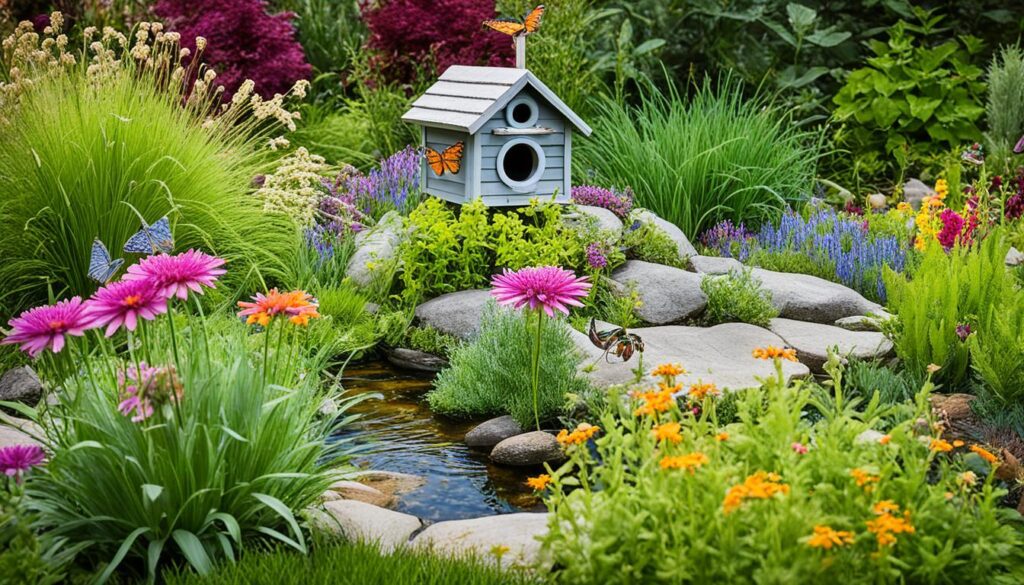
A great garden is more than pretty. It’s about living in harmony with nature. By embracing biodiversity in urban gardens, your garden will buzz with life.
Avoid Pesticides and Embrace Natural Growth
Creating a garden that’s good for wildlife doesn’t mean using harsh chemicals. It’s important to use fewer synthetic pesticides to keep your garden’s ecosystem balanced. Instead, try organic pest control and let nature take its course.
Alternatives to Pesticides
There are many ways to keep pests away from your garden naturally. Start by attracting helpful insects like ladybugs and lacewings, which eat garden pests. Planting certain herbs and flowers together can also keep pests away.
- Hand-pick larger pests like aphids or caterpillars off your plants.
- Use physical barriers like row covers or netting to protect vulnerable crops.
- Sprinkle diatomaceous earth or apply insecticidal soap to target specific pest infestations.
By using fewer chemicals and letting nature do its thing, your garden will be full of life. A bit of weeding and some minor damage to plants is worth it for a healthier garden.
“A garden is a grand teacher. It teaches patience and careful watchfulness; it teaches industry and thrift; above all it teaches entire trust.”
– Gertrude Jekyll
Plant a Wildflower Meadow
Turning your garden into a wildflower meadow is a great idea. It’s easy to care for and helps pollinators. Unlike regular lawns, it doesn’t need much work. It also gives a home to many insects, birds, and small animals.
To make a wildflower meadow, pick a spot that gets a lot of sun and drains well. Pick a mix of native wildflowers that bloom at different times. This way, there’s always food for the pollinators.
- Some popular wildflower meadow plants include:
- Coneflowers
- Blanket flowers
- Black-eyed Susans
- Butterfly weed
- Milkweed
- Planting many native wildflowers makes a healthy garden. It draws in lots of pollinators and wildlife.
- Keep your wildflower meadow tidy by mowing it a few times a year. Do this in late fall or early spring to stop weeds from taking over.
Adding a wildflower meadow to your garden is easy and makes a big difference. It helps local wildlife and looks beautiful. It gives pollinators lots of food and places to live, making your garden a haven for many creatures.
Incorporate Rock Gardens and Gravel Beds
If your garden has heavy clay soil, think about adding rock gardens and gravel beds. These areas are great for plants that love the sun and dry soil. They’re perfect for plants like succulents and alpine species. These plants attract special insects like mason bees that help pollinate them.
Rock gardens and gravel beds are easy to take care of and save water. They make your garden look interesting and support special plants and animals. By using gravel instead of soil, you’ll have fewer weeds, need less water, and can grow plants that love dry places.
Creating a rock garden or gravel bed takes time, but it’s worth it. These gardens become homes for special wildlife. They make your garden a place of beauty and life.
“Rock gardens and gravel beds are a game-changer for gardeners dealing with heavy clay soils. They allow you to introduce a whole new world of fascinating plants and the critters that depend on them.”
| Benefits of Rock Gardens and Gravel Beds | Drawbacks to Consider |
|---|---|
|
|
Looking to make a garden that’s easy to care for and helps wildlife? Adding rock gardens and gravel beds is a great idea. They’re beautiful and support special plants and animals.
Conclusion
By adding wildlife-friendly practices to your garden, you can make a space that helps many creatures. Growing native plants and offering food and water are simple steps. These actions help pollinators, birds, and other wildlife.
Helping your garden’s biodiversity makes your outdoor space more beautiful and supports the local environment. Following wildlife gardening tips can make your garden a better place. It also deepens your connection with nature.
By using wildlife gardening, you help keep your local ecosystem balanced. This creates a sustainable, lively outdoor area for the future.
FAQ
What are the key steps to creating a thriving wildlife garden?
To make a wildlife garden, focus on giving local species the food and shelter they need. Even small spaces can be transformed by growing native plants and offering food and water. By avoiding pesticides, you help create a safe haven for wildlife and enjoy its benefits.
Why are native plants ideal for attracting wildlife?
Native plants are easy to care for and feed local wildlife, from pollinators to birds and small mammals. By planting a variety of native species, your garden will provide food all year round.
How can supplemental food sources benefit wildlife in your garden?
Supplemental food can be a big help to wildlife, especially during tough times. Bird feeders with seeds, nuts, and suet draw in different bird species. Leaving out nectar-rich flowers or rotting fruit helps butterflies and other pollinators.
What types of shelters and nesting spots can you provide for wildlife?
Adding bird boxes, bug hotels, frog pots, and hedgehog houses gives creatures safe places to live. These structures protect them from predators and harsh weather, and are important for breeding and surviving the winter.
How can a garden pond benefit wildlife?
A garden pond is key for attracting and keeping wildlife. It offers water for drinking and breeding for amphibians, and insects that birds and bats eat. This attracts a wide range of species.
What role does a compost pile play in a wildlife-friendly garden?
A compost pile is great for wildlife, supporting worms, slugs, and snails. These creatures are crucial for breaking down organic matter and enriching the soil. Compost piles also offer shelter and places to hide for small animals.
How can you use wildlife-friendly gardening practices to increase biodiversity?
Using fewer synthetic pesticides and letting nature grow is key for a healthy garden. Some weeds and wild growth provide food and shelter for many creatures, from pollinators to small mammals.
What are the benefits of planting a wildflower meadow in your garden?
Planting a wildflower meadow boosts biodiversity. These meadows have a mix of grasses and flowers that feed and shelter many insects, birds, and small mammals.
How can rock gardens and gravel beds attract specialized wildlife?
Rock gardens and gravel beds draw in special wildlife. These areas support tough plants like succulents and alpine species. These plants attract insects that pollinate them, making your garden a unique habitat.
Source Links
- https://www.nhm.ac.uk/discover/seven-ways-to-create-a-wildlife-friendly-garden.html – Seven simple ways to create a wildlife-friendly garden
- https://www.rhs.org.uk/science/conservation-biodiversity/wildlife/encourage-wildlife-to-your-garden – No title found
- https://www.woodlandtrust.org.uk/blog/2020/06/attract-wildlife-to-your-garden/ – No title found
Earth-Friendly Gardening: Techniques for a Greener Outdoor Space
Are you ready to make your garden green in a big way? Earth-friendly gardening is more than a trend. It’s a smart way to care for your space and the world. By choosing to garden this way, you do less work, save cash, and help the planet. Your garden gets healthier, too.
Key Takeaways:
- Earth-friendly gardening is a practical and sustainable approach to landscaping.
- Sustainable gardening practices can reduce your workload and save money.
- By adopting earth-friendly gardening techniques, you can minimize your environmental footprint.
- Sustainable gardening improves the overall health of your garden.
Are you ready to revolutionize your garden with sustainable practices that benefit both your plants and the planet?
Welcome to the world of earth-friendly gardening! In this section, we’re going to talk about sustainable gardening. We’ll show you how it helps both the environment and your plants.
Earth-friendly gardening focuses on sustainability. It aims to create a balance where nature and people can flourish together. By using sustainable practices, we can use less resources, cut down on waste, and protect many kinds of life. This makes your outdoor space greener and helps the planet.
Why should you try sustainable gardening? We’ll look at its benefits now.
1. Environmental Impact: Sustainable gardening cuts down on chemicals and synthetic fertilizers. This reduces pollution and helps wildlife.
2. Soil Health: Practices like composting and mulching make soil fertile. Healthy soil is key for a great garden!
3. Water Conservation: Techniques like rainwater harvesting save a lot of water. This is good for the planet and your water bill.
4. Cost Savings: Using organic methods can help you spend less on fertilizers, pesticides, and water.
5. Beauty and Harmony: Sustainable gardens are beautiful. They create an outdoor space that looks good and is eco-friendly.
6. Connection with Nature: Sustainable gardening helps you connect with nature. It lets you appreciate the natural world more.
Excited to make your garden more eco-friendly? Next, we’ll cover sustainable gardening’s principles and techniques. We’ll discuss water conservation, organic gardening, biodiversity, and more. Get ready to make your outdoor space greener!
The Foundation of Earth-Friendly Gardening
What is a Sustainable Garden?
Understanding earth-friendly gardening starts with knowing what a sustainable garden is. It uses environmental stewardship principles. Its goals include using fewer non-renewable resources and lessening ecosystem harm. Instead of synthetic fertilizers and lots of water, it uses organic methods, supports many living things, and saves water.
A sustainable garden cares for the environment and keeps going with little outside help. It looks after plant, soil, and wildlife health, making a balanced ecosystem. By working with nature, it not only does well itself but also helps the bigger ecosystem.
Building a sustainable garden means adding several things and methods. These involve:
- Native plants: Picking local plants helps area wildlife and cuts down on water and chemical use.
- Composting: Kitchen leftovers and garden trimmings make compost, feeding the soil and cutting down synthetic fertilizer use.
- Water-wise irrigation: Using smart watering, like drip irrigation or collecting rain, saves water and reduces waste.
- Natural pest control: Attracting helpful insects and birds handles pests without chemicals.
- Soil health: Keeping soil healthy with mulching, rotating crops, and covering the soil supports plant life and strength.
Check out this table to see the important parts of a sustainable garden:
| Elements of a Sustainable Garden | Description |
|---|---|
| Native plants | Choosing plants fit for the local weather and soil saves water and supports different life forms. |
| Composting | Turning waste into compost enriches the soil and reduces the need for artificial fertilizers. |
| Water-wise irrigation | Smart watering methods like drip systems and collecting rain cuts down on water use. |
| Natural pest control | Inviting insects and birds that eat pests naturally reduces chemical pesticide use. |
| Soil health | Improving the soil with mulching, planting different crops in turn, and ground cover helps plants grow better. |
With a sustainable garden, you can have a lively outdoor area that’s good for the environment. Next, we’ll explore more about how to make and care for an earth-friendly garden.
Water Conservation Techniques
Water conservation is key for earth-friendly gardening. You can cut down on water use and still have a great garden. Let’s look at ways to use less water and save this vital resource.
Gathering rainwater is a smart move. You can collect and store rainwater by setting up a rain barrel or a system. This helps you use less tap water and stops runoff and erosion.
Using smart irrigation is crucial for saving water in gardens. Systems like drip irrigation give water right to plant roots, which cuts down waste. Setting a timer for early morning or late evening can also help reduce evaporation.
Mulching is another great water-saving tip. It keeps the soil moist by stopping water from evaporating. Put a layer of organic mulch around your plants to help keep water in the soil.
Choosing the right plants can also save water. Go for plants that need less water and are right for your area. Also, plant things with the same water needs close to each other. This makes watering more efficient.
Keep an eye on your garden’s water use, too. Check for leaks in your watering systems and fix them fast. Catching leaks early helps stop water from being wasted.
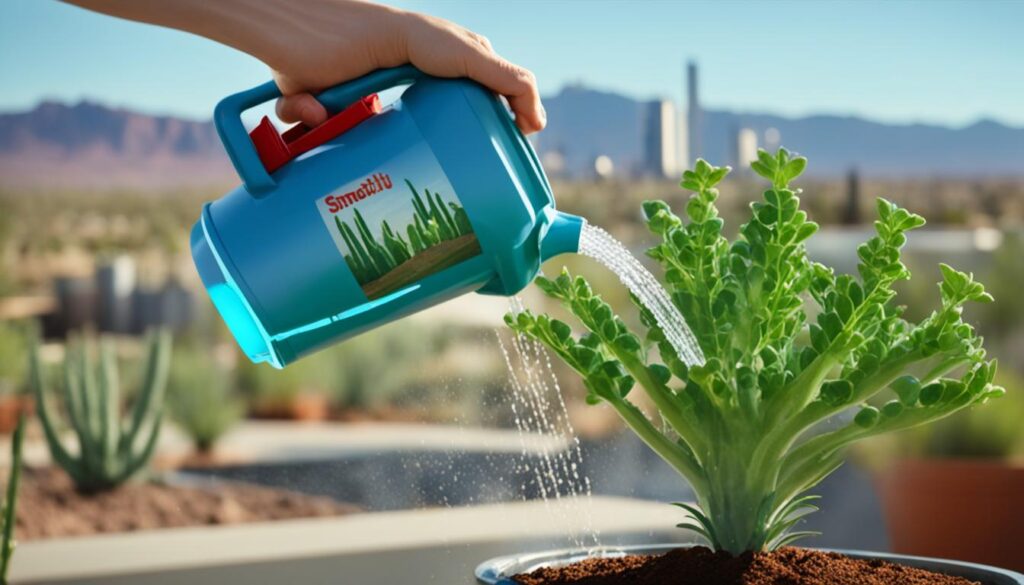
Using these tips, you can cut back on water in your garden. This makes your outdoor space more sustainable and good for the planet.
| Technique | Benefits |
|---|---|
| Collecting rainwater | – Reduces reliance on municipal water supplies – Prevents stormwater runoff and erosion |
| Efficient irrigation methods | – Minimizes evaporation and waste – Optimize watering times |
| Mulching | – Reduces evaporation and maintains soil moisture – Improves soil health |
| Proper plant selection | – Reduces water requirements – Supports local ecosystems |
| Regular maintenance | – Prevents water waste from leaks – Ensures efficient water usage |
Organic Gardening Methods
Organic gardening helps our planet. It lets you grow a beautiful garden without bad chemicals. We’ll see why organic gardening is good and how to do it.
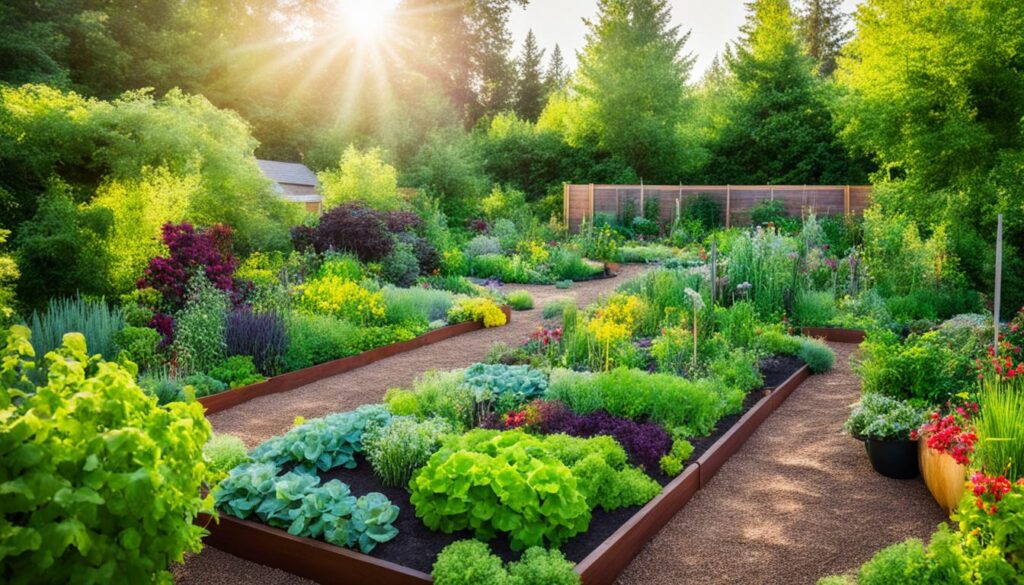
“Organic gardening is more than just growing plants without synthetic chemicals. It’s about nurturing and supporting the natural processes that sustain life.”
Organic gardening has great benefits:
- 1. Environmental Safety: It makes a healthy place by avoiding harmful chemicals. This helps wildlife and keeps water clean.
- 2. Healthier Produce: Foods grown organically are safe and full of nutrients. They’re better for you and your family.
- 3. Soil Health: This kind of gardening makes the soil strong and fertile. Healthy soil means a better garden.
- 4. Biodiversity: Organic gardens welcome bees, friendly bugs, and animals. They don’t use chemical bug killers.
Now, here’s how to garden organically:
- Choose Organic Seeds or Starts: Pick seeds or starts that are organic. This makes sure your plants are safe and natural.
- Improve Soil Quality: Add things like compost or old manure to your soil. This makes it better for your plants.
- Natural Fertilizers: Feed your plants with organic stuff like compost tea. This keeps the soil healthy for a long time.
- Companion Planting: Grow plants like marigolds or basil together. This keeps pests away and brings in good bugs.
- Biocontrols: Use bugs like ladybugs to fight pests. They help without needing chemicals.
- Mulch: Use organic mulch around plants. It stops weeds and keeps soil moist.
Using these tips, your garden can be safe and full of life. Enjoy gardening with nature’s help!
Encouraging Biodiversity
Biodiversity is key for a healthy and strong garden. By bringing more biodiversity to your garden, you make it prettier. You also help the planet stay healthy.
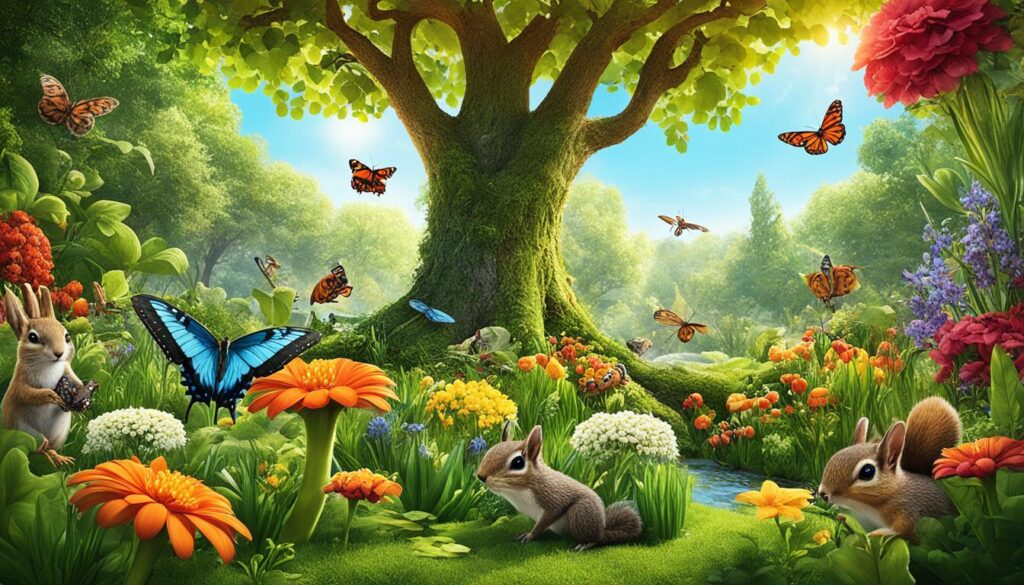
- Plant native species: Native plants fit well with the local weather. They give food and homes to local animals.
- Create wildlife habitats: Add things like birdhouses, bat boxes, and bee hotels. They draw lots of different animals.
- Provide water sources: Put in a bird bath, pond, or small water spot. It will attract birds, bugs, and others.
- Attract beneficial insects: Grow flowers that pull in pollinators like bees and butterflies. This also brings in bugs that eat pests.
- Plant a diverse range of species: Use plants of many sizes, shapes, and bloom times. This draws a big mix of wildlife to your garden.
By welcoming more biodiversity, you make your garden thrive. It will support many kinds of plants and animals.
Reducing Your Garden’s Carbon Footprint
Making your garden more sustainable is key. We’ll talk about how gardens add to carbon emissions. We’ll also give tips to reduce your garden’s impact. Using sustainable designs and eco-friendly materials helps.
Eco-Friendly Garden Maintenance
Maintaining an eco-friendly garden means using sustainable ways all year. By following these tips for eco-friendly garden care, you keep your garden green:
- Proper pruning techniques: Pruning is key in keeping a garden healthy. By pruning selectively, you remove only the bad parts. This helps with airflow and lowers pest risks. Always use clean, sharp tools and sterilize them after each cut to stop disease spread.
- Responsible use of garden tools and equipment: Whenever you can, use hand tools like pruners and weeders. They use less energy. If you need power tools, go for those that are electric or battery-run. They are quieter and pollute less than gas ones.
- Effective waste management: Don’t throw away organic waste such as leaves. Compost them to reduce landfill waste and make good soil. Also, consider leaving grass clippings on your lawn. They break down and feed the grass naturally.
Small changes in how you care for your garden can help the planet. Using these green techniques makes your garden and the earth healthier.
Comparison of Garden Tools
| Tool Type | Advantages | Disadvantages |
|---|---|---|
| Manual Tools | Low energy consumption Quiet operation No air pollution |
Requires physical effort Not suitable for large areas |
| Electric Tools | Lower noise levels compared to gas-powered tools No direct emissions |
Dependency on electricity Limited mobility due to cord length or battery life |
| Gas-Powered Tools | Greater power for heavy-duty tasks Longer running time |
Noise pollution Direct emissions of pollutants More maintenance |
Inspiring Examples of Earth-Friendly Gardens
Want to make your garden eco-friendly? Look at these sustainable gardens. They show how to be green in any space. From tiny city lots to big suburban areas.
The Field of Dreams is in the city. It proves small places can become green havens. It uses vertical plants, pots, and collects rainwater. This makes it productive but eco-friendly.
The Green Haven is great for those with more land. It has native plants, rain gardens, and special paving. These choices help wildlife, save water, and stop flooding. Recycled paths and solar lights add to its green touch.
Meadowsong Sanctuary is out in the countryside. It follows permaculture and regenerative farming. This means it supports itself. It uses natural ways to keep pests away and plants that help each other. It also welcomes animals.
For more eco-gardening tips, visit the Royal Horticultural Society. They have a guide full of ideas. It helps make gardens both pretty and green.
Conclusion
Earth-friendly gardening is more than just a trend. It’s a smart way to design your outdoor space. It helps the planet and makes your garden better. You will work less, save money, and help nature.
This guide showed you how to garden in a planet-friendly way. We talked about saving water and avoiding chemicals. Encouraging various plants and animals is also key.
Now, it’s your turn to try these green gardening methods. By doing this, you help our planet and get a lovely garden. So, put on your gardening gloves. Let’s take a step towards eco-friendly gardening together!
FAQ
What is earth-friendly gardening?
It’s gardening in a way that helps the planet. This means using less water and avoiding harmful chemicals. It also means growing plants that help the environment.
Why is earth-friendly gardening important?
This type of gardening has many benefits. It saves water and helps the soil. It also makes your garden a healthier place. Plus, it’s good for the earth.
How can I conserve water in my garden?
To save water, collect rainwater and choose smart watering systems. Use mulch to keep soil moist. Also, grow plants that don’t need much water.
What are organic gardening methods?
Organic gardening means using natural stuff to help your garden grow. This includes things like compost and avoiding man-made chemicals. It keeps your garden and the earth healthier.
How can I encourage biodiversity in my garden?
For more biodiversity, grow local plants and make homes for wildlife. Also, attract helpful bugs and animals. This makes your garden full of life and good for nature.
How can I reduce my garden’s carbon footprint?
Use eco-friendly designs and materials in your garden. Compost your waste and cut down on gas tools. These steps help your garden pollute less.
What are some eco-friendly garden maintenance practices?
Keep your garden green by pruning correctly and using efficient tools. Also, handle waste the smart way. These practices keep your garden healthy and green all year.
Can you provide examples of earth-friendly gardens?
Yes! There are many great examples out there. They show how to garden in ways that are good for the earth. You can find ideas for your own garden by looking at these examples.
Source Links
- 10 Must-Have Blooms for Your 2025 Garden
- The Health Advantages of Gardening You Need to Know
- How to Create a Small Vegetable Garden Layout Plan: A Beginner’s Guide
- DIY Garden Projects for Small Spaces: Upcycling Ideas to Maximize Your Garden
- Watering Techniques for Small Gardens: Ensuring Your Plants Thrive
- Small Border Plants for Landscaping: Adding Beauty and Functionality to Your Garden
- Year-Round Small Space Gardening: Seasonal Planting Tips for Maximum Harvest
- Essential Tools for Small-Space Gardening: What You Really Need
- The Ultimate Guide to Container Vegetables: What to Grow in Small Spaces
- Budget-Friendly Gardening: How to Create a Thriving Garden on a Tight Budget
- How to Optimize Sunlight in Small Gardens: Tips for Better Plant Growth
- DIY Vertical Planters: Creative Ideas for Small Space Gardening
- Companion Planting for Small Vegetable Gardens: Boost Growth and Deter Pests
- Container Gardening Essentials: Choosing the Right Pots, Soil, and Plants
- Vertical Gardening Techniques: Maximizing Your Small Space with Climbers and Vines
- How to Build a Raised Bed Garden in a Small Backyard: Step-by-Step Guide
- The Best Vegetables for Small-Space Gardens: High-Yield Varieties You Need to Grow
- Smart Vegetable Garden Layouts for Small Spaces: Maximizing Your Green Thumb in Compact Areas
- 40. Best Practices for Managing a Sustainable Garden Year-Round
- Building a Wildlife Pond for Biodiversity
- Advanced Techniques in Sustainable Gardening
- How to Create a No-Till Garden
- The Mental Health Benefits of Gardening
- Using Technology to Enhance Sustainable Gardening
- Getting Certified Organic: Steps and Benefits
